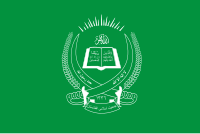Jamiat-e Islami
| Jamiat-e Islami | |
|---|---|
| جمعیت اسلامی افغانستان | |
 | |
| Leader | Salahuddin Rabbani (Northeastern faction)
Anti-Communism
Anti-Sovietism Afghan Civil War (1992–96)
Afghan Civil War (1996–2001) War in Afghanistan (2001–2021) |
| Designated as a terrorist group by | |
| Flag |  |
| Colours | Green White |
Jamayat-E-Islami (also rendered as Jamiat-e-Islami and Jamiati Islami;
History
Early years
Jamiat "emerged" in 1972 from among "the informal Islamist groupings that had existed since the 1960s". Led by Burhanuddin Rabbani, a professor of Islamic theology at
In Pakistan, Professor Rabbani gathered important people and continued to build the party. Sayed Noorullah Emad, who was then a young Muslim at Kabul University became its general secretary and, later, its deputy chief. Some of its prominent commanders included Ustad Zabihullah],
Massoud–Hekmatyar split
Ahmad Shah Massoud and Gulbuddin Hekmatyar were both early followers of Rabbani, being Kabul University students at the time. Hekmatyar broke away from Jamiat in 1976 to found his own party: Hezb-e Islami.[5]
The two groups formed the two main tendencies of the Islamist movement in Afghanistan, and after the April 1978 coup and the brutality of the invading Soviet Army, the two strongest Afghan mujahideen groups in the 1980s.[6]
Jamiat
Rabbani and the Jamiat advocated "building of a widely based movement that would create popular support", a gradualist strategy of infiltration of society and the state apparatus to gain power.[7] Jamiat was dominated by Tajiks but had a greater `tribal and regional cross section` than other groups,[6] and was willing to seek "common ground" with non-Islamists.[4] It gained prominence because of the battlefield success of Ahmad Shah Massoud.[4]
Hezb-i Islami
Hezb-i Islami was overwhelmingly Ghilzai Pashtun, and backed by Pakistan president
Soviet invasion
After the Soviet invasion in Afghanistan in 1979, Massoud organised a mujahideen group in Parwan Province to fight against the Communist government and their Soviet allies. This group grew to control multiple provinces and include thousands of fighters. The Soviet Army launched a series of major offensives to attempt to destroy their forces, but they were unable to engage most of Massoud's men.[citation needed]
Battles between Jamiat and Hezb-i Islami
After the withdrawal of the Soviet troops in 1989, the mujahideen groups continued to wear down government forces. However they also fought among each other: in June 1990, battles between Jamiat and Gulbuddin's Hezb in Logar and Parwan caused hundreds of casualties on each side.[6]
1991–2001
In 1991, Jamiat's forces participated in the Gulf War fighting against Ba'athist Iraq.[9]
In 1992, the communist government collapsed entirely. Jamiat's forces were among the first to enter
By 1995, the Taliban, which had seized control of much of southern Afghanistan with comparative ease the previous year, were advancing on Kabul. Jamiat rejected Taliban demands that they surrender, and the Taliban rejected Jamiat's offer to join a peaceful political process leading towards a general election. In March 1995, Massoud handed the Taliban their first major loss, however, with the aid of Saudi and Pakistani backing, they regrouped and launched and offensive in mid-1996. Massoud ordered the retreat of his troops among them Jamiat to avoid another bloodbath.[citation needed]
Following the capture of Kabul by the Taliban, the major mujahideen factions put aside their feuds and formed the
On 9 September 2001, just two days before the September 11 attacks in the United States, Massoud was assassinated by two suicide bombers, probably at the instigation of al-Qaeda. Immediately afterwards Taliban forces launched a major offensive against United Front positions. Mohammed Qasim Fahim was chosen to succeed Massoud as leader of Jamiat's military wing and repulsed the Taliban offensive. With extensive assistance from an American-led coalition in October and November 2001 (see War in Afghanistan (2001–2021)), United Front forces recaptured most of Afghanistan.
Jamiat's founder and leader, Burhanuddin Rabbani, was assassinated in 2011.[10] His son, Salahuddin Rabbani, has since led the party.
After the Taliban came to power in 2021, Salahuddin Rabbani left Afghanistan.
See also
Sources
References
- ^ "Jamiat-e Islami Party Leader Announces Formation of Supreme Decision-Making Council". Afghanistan International. 20 March 2024. Retrieved 20 March 2024.
- ^ Abasin Zaheer (20 January 2011). "JIA to see leadership changes: Faqiri". Pajhwork Afghan News. Retrieved 17 July 2011.mirror
- ^ ISBN 9780870032851. Retrieved 2 November 2014.
- ^ a b c d Kepel, Gilles (2002). Jihad: on the trail of Political Islam. Belknap. p. 141.
- ISBN 9780870032851. Retrieved 2 November 2014.
- ^ ISBN 9781780761220. Retrieved 2 November 2014.
- ^ "Afghanistan: Pakistan's Support of Afghan Islamists, 1975–79". Library of Congress. 1997. Retrieved 11 July 2008.
- ISBN 978-0-521-39700-1.
- ^ "DESERT SHIELD AND DESERT STORM A CHRONOLOGY AND TROOP LIST FOR THE 1990–1991 PERSIAN GULF CRISIS" (PDF). apps.dtic.mil. Archived (PDF) from the original on 12 April 2019. Retrieved 18 December 2018.
- ^ "Former Afghanistan president Burhanuddin Rabbani killed in Kabul blast". www.telegraph.co.uk. Retrieved 19 August 2021.
